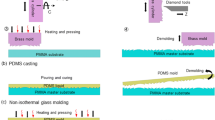Abstract
Chalcogenide glass (ChG) is widely studied due to its wide infrared transmission window, low refractive index temperature coefficient, and low dispersion coefficient. Precision glass molding (PGM) and single-point diamond turning (SPDT) are representative high-efficiency and high-precision methods for ChG processing. However, the high softening degree of ChG under high-temperature conditions leads to abnormal gas release and severe mold adhesion which deteriorate surface quality. Although SPDT typically facilitates high-precision machining, it has limited efficacy in long-term, large-area, large-depth processing; this limitation causes severe tool wear due to the high hardness and brittleness of ChG material. A new process combining the advantages of PGM and SPDT technology is proposed to fabricate aspheric lenses on ChG (IRG202) by ultra-precision and high-efficiency machining. The pre-molding of ChG by PGM reduces cutting loss during aspheric lens machining by SPDT. The machined aspheric lenses have the high quality with a form error of PV 103.5 nm and surface roughness Ra of 8.3 nm. The processing efficiency of each single lens is increased by almost 8 times over the traditional method. The proposed ChG aspheric lens fabrication process maintains high precision even under mass production conditions.














Similar content being viewed by others
References
Sanghera JS, Shaw LB, Aggarwal ID (2002) Applications of chalcogenide glass optical fibers. C R Chim 5:873–883. https://doi.org/10.1016/s1631-0748(02)01450-9
Danto S, Houizot P, Boussard-Pledel C, Zhang XH, Smektala F, Lucas J (2006) A family of far-infrared-transmitting glasses in the ga–ge–te system for space applications. Adv Funct Mater 16(14):1847–1852. https://doi.org/10.1002/adfm.200500645
Wilhelm AA, Boussard-Pledel C, Coulombier Q, Lucas J, Bureau B, Lucas P (2007) Development of far infrared-transmitting te based glasses suitable for carbon dioxide detection and space optics. Adv Mater 19(22):3796–3800. https://doi.org/10.1002/adma.200700823
Bae D, Yeo J, Lee H (2013) A study on a production and processing technique for a GeSbSe aspheric lens with a mid-infrared wavelength band. J Korean Phys Soc 62(11):1610–1615. https://doi.org/10.3938/jkps.62.1610
Bureau B, Zhang XH, Smektala F, Adam J, Troles J, Hong-Li M et al (2004) Recent advances in chalcogenide glasses. J Non-Cryst Solids 345–346:276–283. https://doi.org/10.1016/j.jnoncrysol.2004.08.096
Kulakova NA, Nasyrov AR, Nesmelova IM (2010) Current trends in creating optical systems for the IR region. J Opt Technol 77(5):324. https://doi.org/10.1364/JOT.77.000324
Song B, Yang Y, Jia Z, Chen F, Lin C, Dai S et al (2013) Optical loss and residual stress measurement of infrared chalcogenide glasses and analysis on its influencing factors. In: International Conference on Optics in Precision Engineering and Nanotechnology. 87693R. https://doi.org/10.1117/12.2021071
Zhou T, Yan J, Masuda J, Oowada T, Kuriyagawa T (2011) Investigation on shape transfer ability in ultraprecision glass molding press for microgrooves. Precis Eng 35(2):214–220. https://doi.org/10.1016/j.precisioneng.2010.09.011
Cha DH, Kim H, Park HS, Hwang Y, Kim J, Hong J et al (2010) Effect of temperature on the molding of chalcogenide glass lenses for infrared imaging applications. Appl Opt 49(9):1607–1613. https://doi.org/10.1364/ao.49.001607
Yan J, Tamaki JI, Syoji K, Kuriyagawa T (2004) Single-point diamond turning of CaF2 for nanometric surface. Int J Adv Manuf Technol 24(9–10):640–646. https://doi.org/10.1007/s00170-003-1747-2
Troutman JR, Owen JD, Zare A, Harriman TA, Lucca DA, Davies MA (2016) Cutting mechanics and subsurface integrity in diamond machining of chalcogenide glass. Procedia CIRP. 45:135–138. https://doi.org/10.1016/j.procir.2016.03.020
Troutman JR, Barnhardt DL, Shultz JA, Owen JD, Defisher S, Davies MA et al (2016) Machining and metrology of a chalcogenide glass freeform lens pair. Procedia Manuf 5:669–683. https://doi.org/10.1016/j.promfg.2016.08.055
Davies MA, Evans CJ, Patterson SR, Vohra V, Bergner BC (2003). Application of precision diamond machining to the manufacture of micro-photonics components. In: Proceedings of spie; Bellingham WA: 94–108. https://doi.org/10.1117/12.506373
Zhou T, Zhou Q, **e J, Liu X, Wang X, Ruan H (2018) Elastic-viscoplasticity modeling of the thermo-mechanical behavior of chalcogenide glass for aspheric lens molding. Int J Appl Glass Sci. 9(2):252–262. https://doi.org/10.1111/ijag.12290
Zhou T, Liu X, Liang Z, Liu Y, **e J, Wang X (2017) Recent advancements in optical microstructure fabrication through glass molding process. Front Mech Eng 12(1):46–65. https://doi.org/10.1007/s11465-017-0425-2
Owen JD, Davies MA, Schmidt D, Urruti EH (2015) On the ultra-precision diamond machining of chalcogenide glass. CIRP Ann 64(1):113–116. https://doi.org/10.1016/j.cirp.2015.04.065
Arsecularatne JA (1997) On tool-chip interface stress distributions ploughing force and size effect in machining. Int J Mach Tools Manuf 7(37):885–899. https://doi.org/10.1016/S0890-6955(97)00001-1
Cai MB, Li XP, Rahman M (2007) Study of the mechanism of nanoscale ductile mode cutting of silicon using molecular dynamics simulation. Int J Mach Tools Manuf 47(1):75–80. https://doi.org/10.1016/j.ijmachtools.2006.02.016
Liu B, Fang F, Li R, Xu Z, Liang Y (2018) Experimental study on size effect of tool edge and subsurface damage of single crystal silicon in nano-cutting. Int J Adv Manuf Technol 98(5–8):1093–1101. https://doi.org/10.1007/s00170-018-2310-5
Huang W, Yan J (2020) Surface formation mechanism in ultraprecision diamond turning of coarse-grained polycrystalline ZnSe. Int J Mach Tools Manuf 153:103554. https://doi.org/10.1016/j.ijmachtools.2020.103554
Funding
This work was financially supported by National Natural Science Foundation of China (Nos. 51775046, 51875043, 52005040), the China Postdoctoral Science Foundation (No. 2019M660480), and the Bei**g Municipal Natural Science Foundation (JQ20014).
Author information
Authors and Affiliations
Corresponding author
Ethics declarations
Ethical statement
Authors state that the research was conducted according to ethical standard.
Consent to participate
Not applicable.
Consent for publication
Not applicable.
Conflict of interest
The authors declare no competing interests.
Additional information
Publisher's Note
Springer Nature remains neutral with regard to jurisdictional claims in published maps and institutional affiliations.
Rights and permissions
About this article
Cite this article
Zhou, T., Zhang, C., He, Y. et al. Aspheric lens processing of chalcogenide glass via combined PGM-SPDT process. Int J Adv Manuf Technol 120, 5855–5864 (2022). https://doi.org/10.1007/s00170-022-09112-4
Received:
Accepted:
Published:
Issue Date:
DOI: https://doi.org/10.1007/s00170-022-09112-4




